California, Florida, and Illinois are receiving the largest pieces of the federal high speed rail pie. According to the a release from the White House, California will receive $2.32 billion for a forked line running from San Diego to Los Angeles and splitting in Northern California with spurs to San Francisco and Sacramento. Florida will receive $1.25 billion for a new line from Tampa to Orlando, with an additional line connected Orlando to Miami as a part of a “long-term vision.”
“By investing in high speed rail, we’re doing so many good things for our country at the same time,” said Vice President Biden, according to a statement from the White House . “We’re creating good construction and manufacturing jobs in the near-term. We’re spurring economic development in the future. We’re making our communities more livable—and we’re doing it all while decreasing America’s environmental impact and increasing America’s ability to compete in the world.”
Illinois will receive $1.13 billion to upgrade its corridor to St. Louis, far less than the $4.5 billion the state sought.
While this may seem like a set back from Illionis, the Midwest region as a whole received several other significant grants, which should eventually link to a hub in Chicago. Wisconsin and Minnesota will received $823 for a new line from Milwaukee to Madison, WI, with projects laying the “foundation” for a line connected from Milwaukee to Chicago and a “long-term vision” for a Mineapolis to Madison line. Michigain/Illinois/Indiana are receiving a $244 million grant for upgrades along a line stretching from Chicago to Kalamazoo to Detroit to Pontiac, MI. Ohio will be granted $400 million for a new line conntecting Cleveland to Columbus to Dayton to Cincinatti.
The Northeast Corridor, with the nation’s largest existing rail ridership, is receiving a comparatively small grant of $1.91 billion in funding, spread across nine states and the District of Columbia.
According to the Boston Globe, the complexities stemming from multi-state enviornmental impact statements hindered the region’s bid.










